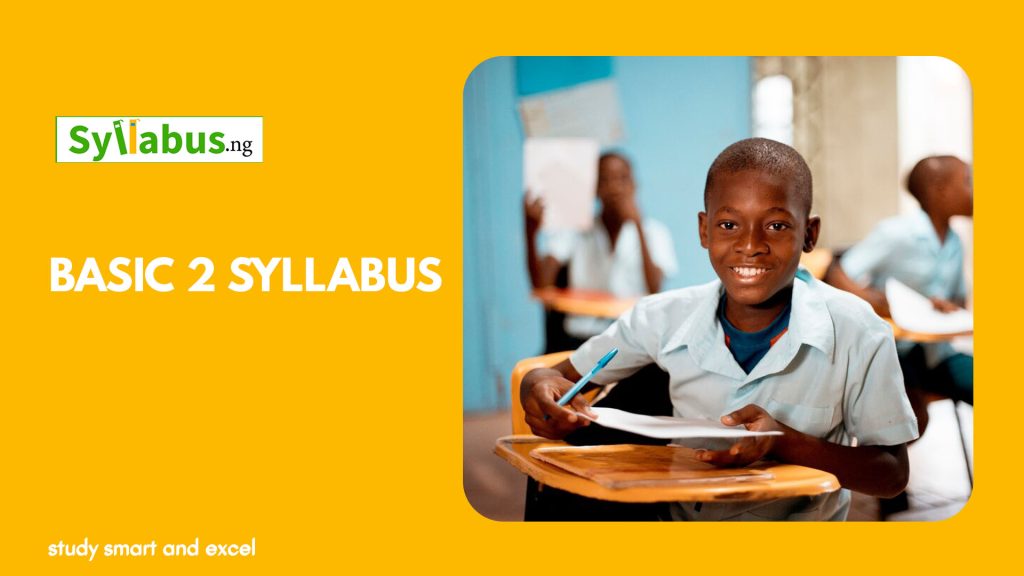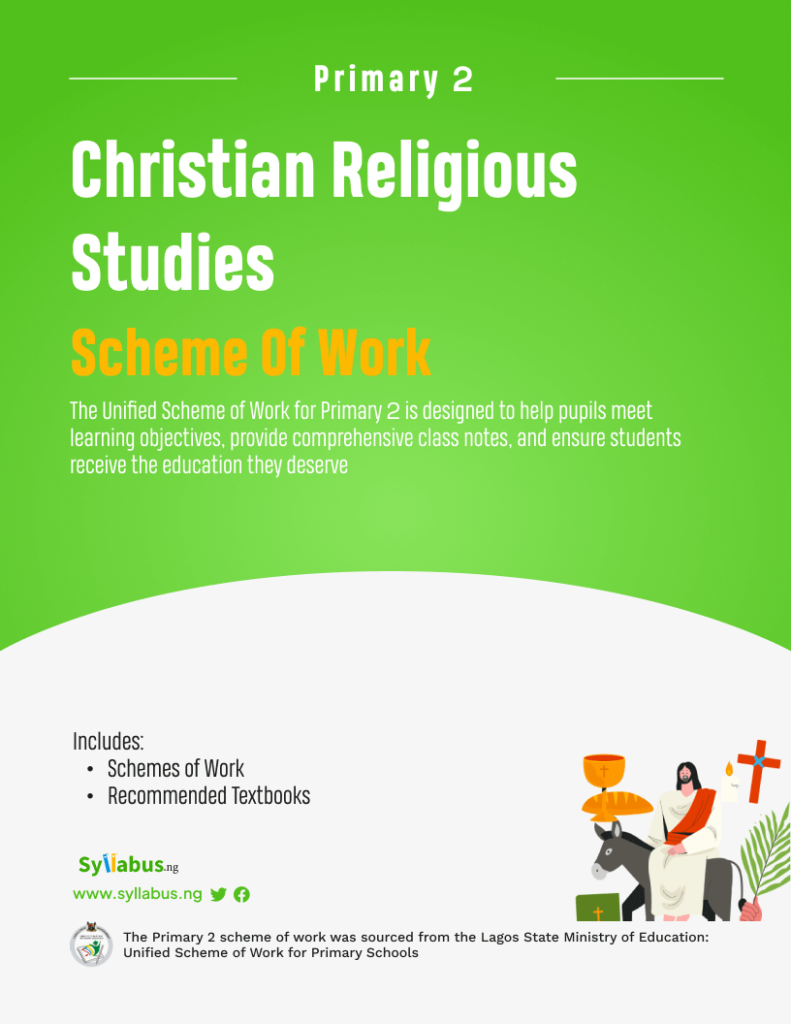Download the Unified Basic 2 Scheme of Work for Christian Religious Studies, to serve as a guide for educators and primary school teachers

Home » Primary 2 Scheme of Work » Primary 2 Christian Religious Studies (CRS) Scheme of Work
Just as the Primary Scheme for Christian Religious Studies for Primary 1 is centered on getting to know God, the Scheme for Primary 2 focused on getting to know Jesus, the topics for the session will get them to know more about Jesus and his teachings.
The topics covered are; Jesus the man of God, Jesus the man of prayer, Jesus’ teachings on prayer, types of prayer, forms of prayer, the power of prayer, the early age of Jesus, the power of Jesus, the fall of man, plan of salvation, etc.

Know what’s expected of you as an educator
Download the Lagos State Unified Scheme of Work for Primary 2 Christian Religious Studies (CRS)
| LAGOS STATE GOVERNMENT MINISTRY OF EDUCATION UNIFIED SCHEMES OF WORK FOR PRIMARY SCHOOLS | ||
| Christian Religious Studies Scheme of Work for Primary/Basic 2 | ||
| CLASS | Primary/Basic 2 | |
| SUBJECT | Christian Religious Studies | |
| TERM | First Term | |
| WEEK | TOPICS | Learning Objectives |
| 1 | ||
| 2 | Jesus the man of prayer | By the end of the lesson, pupils should be able to: 1. Identify Jesus as a man of prayer 2. State the reasons why Jesus prayed 3. Mention instances in their lives when they ought to pray |
| 3 | Jesus the man of prayer (Contd.) | By the end of the lesson, pupils should be able to: 1. Explain the importance of prayers In the life of a Christian. 2. State the significance of prayer in the life of Jesus 3. Use passages from the Bible to explain the instances when and why Jesus prayed. |
| 4 | Jesus teachings on prayer | By the end of the lesson, pupils should be able to: 1. Discuss Jesus teaching on prayer 2. Describe bow Jesus taught us to pray 3. Recite the Lord’s prayer |
| 5 | Jesus teachings on prayer | By the end of the lesson, pupils should be able to: 1. Discuss die value of constancy in prayer 2. Describe right attitude to prayer 3. Explain the reasons Jesus asked us to pray. |
| 6 | Types of prayer i. Intersessory ii. Thanksgivng iii. Confession of sin iv. Petition v. Supplication | By the end ofthe lesson, pupils should be able to: 1. Define prayer 2. list wpes of prayer 3. Enumerate some of the things to pray for |
| 7 | MID-TERM BREAK | |
| 8 | Types of prayer i. Petition prayer ii. Praise and worship iii. Supplication | By the end of the lesson, puplls should be able to: 1. Narrate major way we can communicate to God 2. List types of prayers 3. Explain why Christians pray |
| 9 | Forms of Prayer i. Verbalizing ii. Meditation iii. Adoration iv.Groaning | By the end of the lesson, pupils should be able to: 1. Descnbe what prayer is 2. mention the different forms of prayer 3. state benefit of prayer |
| 10 | Forms of Praycr | By the end of the lesson, pupils should bc able to: i. Explain the different forms of prayer ii. Identify people in the Bible that prayed iii. Statc reasons why people pray the different forms of prayer |
| 11 | REVISION | |
| 12 | EXAMINATION | |
| CLASS | Primary/Basic 2 | |
| SUBJECT | Christian Religious Studies | |
| TERM | Second Term | |
| WEEK | TOPICS | Learning Objectives |
| 1 | REVISION Prayer position i. Standing ii. Kneeling iii. Prostrating iv. Lying down v. Sitting | By the end of the lesson, pupils should be able to: i. List different positions Christians could take while praying ii. Name people in the Biblc that prayed in the different positions iii. State possible reasons why people pray in these different positions |
| 2 | The power of prayer | By the end of the lesson, pupils should be able to: 1. Define power 2. Identify Bible evidences of the power of prayer 3. Mention people in the Bible that prayed |
| 3 | The power of prayer | By end of the lesson, pupils should be able to: i. Mention something that can hinder our prayers ii. State what they asked for in their prayers iv. Explain how God answered their prayers |
| 4 | The Early life of Jesus | By the end of the lesson, pupils should be able to: i. Narate the birth ofJesus ii. Explain the massage of the angel to Joseph iii. Name the gifts presented to Jesus by the three wise men |
| 5 | Toe early life of Jesus | By end of the lesson, pupils should be able to: 1. Explain the presentation of Jesus in the temple 2. List the names of people who were at the presentation of Jesus in the temple 3. State what Simeon said at the temple at the presentation of Jesus |
| 6 | Jesus preparation for His ministry | By the end of the lesson, pupils should be able to: 1. define ministry 2. the events that prepared Jesus for Ministry 3. Explain the baptism of Jesus Chnst |
| 7 | MID-TERM BREAK | |
| 8 | Jesus preparation for His ministry | By the end orthc lesson, pupils should be able to: 1. Define temptation 2. Describe the temptation of Jesus 3. Mention the names of Jesus disciple 4. Discuss the significance of Jesus calling the 12 to be His disciples |
| 9 | The power of Jesus i. Calming the sea ii. Feeding of five thousand people iii. The great catch of fishes iv. Jesus turned water into wine | By the end of the lesson, pupils should be able to: 1. Narnte the eveny that show the power of Jesus 2. Explain why Jesus helped the people in the events 3. Discuss importance of obedience as illustrated in the geat catch of fishes 4. Discuss the turning of water into wine |
| 10 | The power of Jesus | By the end ofthe lesson, pupis should be able to; 1. Discuss the more powers of Jesus e.g. Power over evil, diseases and death 2. Narrate the stories of the paralized man whom Jesus healed 3. Name people in the Bible who Jesus raised from die dead 4. State the significance of Jesus healing raising from die dead, power over sin and death |
| 11 | REVISION | |
| 12&13 | EXAMINATION | |
| CLASS | Primary/Basic 2 | |
| SUBJECT | Christian Religious Studies | |
| TERM | Third Term | |
| WEEK | TOPICS | Learning Objectives |
| 1 | REVISION The power of Jesus (Contd.) | By the end or the lesson, pupils should be able to: I. Define power ii. Narrate the story of Mary Magdalene iii. Explain the story learnt from the story iv. Identify other people whose sins were forgiven by Jesus v. State the importance of forgivcncss of sins in our Christian live |
| 2 | Jesus teaching on the Kingdom of God | By the end of the lesson, pupils should be able to: i. Define parables ii. List types of parable iii. Narrate the stories or parables illustrating the Kngdom of God |
| 3 | Jesus teaching n the kingdom of God | By the end oftle lesson, pupils should be able to: i. Explain be parable of the sower and the ten virgins ii. Mention the lessons in the parables iii. State the importance of these lessons iv. List various tHings we should do in preparation for the kingdom of God |
| 4 | The fall of man | By the end of the lesson, pupils should be able to: i. Define the term creation ii. Narrate the account of how God created Adam and Eve iii. Identify the differences between the creation of Adam and Eve and other creations |
| 5 | The fall of man | By end ofthe lesson, pupils should be able to: 1.Define ühe following terms i. Disobedience ii. Punishment 2. Explain the disobedience of Adam and Eve 3. Discuss the punishment God gave to Adam, Eve and the Serpent |
| 6 | Plan of salvation | By the end of the lesson, pupils should be able to: i. Define salvation ii. Narrate God’s promise of salvation iii. State the Importance of salvation |
| 7 | MID-TERM BREAK | |
| 8 | Plan of salvation | By the end of the lesson, pupils should be able to: 1. Give the definition of obedience & faith 2. Explain how Abraham demonstrated his faith and obedience. 3. Enumerate the things promised to Abraham. 4. Discuss the rewards of obedience |
| 9 | Plan of salvation (contd.) | By the end ofthe lesson, pupils should be able to: i. Narrate the story of the birth of Jacob ii. Explain how Jacob cheats his brother and father iii. Discuss Jacob’s dream and Bethel; iv. State the blessings promised to acob |
| 10 | Plan of salvation (contd.) | By the end of the lesson, pupils should be able to: i. Narrate the story of Joseph and Moses ii. Discuss Joseph’s dreams iii. Explain the events that led to the release of the Israelites from Egypt iv. Describe the events of the crossing or the Red sea |
| 11-12 | Recap &Examinmon | |
1. Akinrodoye Ariyo et al, Tanus RNV CRS Pry 2, Tanus, 2015.
2. Alexander A.a. et al, Extension Basic RNV for Pry Sch Lower Basic Edu Bk 2, Extension, 2015.
3. Lynda Uche, MMakwe, WABP Christian Religious Studies for Pry Sch Bk 2. WABP, 2017.
4. Olufemi J. Oluga, Christian Religious Studies 2.
5. Olusola Bamide et al, Melrose Religious and National Values for Pry Sch Bk 2, Melrose, 2015.
6. Fatoken S.A, et al, RNV for Pry School CRS 2, Rasmed, 2016.
7. J.N. Anyalebechi & Chris Mario Umegbo, Pacific RNV Part1 CRS for Lower UBE Pry 2, Pacific, 2015.
8. Adeyinka A.A et al, Bounty RNV for Pry sch Bk 2, Bounty, 2016.
9. A.M. Anuforo, Comprehensive RNV CRS for Pry Schs 2, Literamed, 2015.
10. H.lshola & co. Basic Christian Religious Knowledge for Pry Sch 2, Learn Africa, 2015.
11. Falake A.S. et al, Evans Modular Christian Rel. Studies for Pry sch Bk 2, Evans, 2015.
12. Golden John, Golden J. & Golden, Covenant Bible Stories for Schools Bk 2, Learning Solution, 2015.

Know what’s expected of you as an educator
Download the Lagos State Unified Scheme of Work for Primary 2 Christian Religious Studies (CRS)